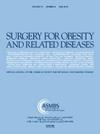术前非酒精性脂肪性肝炎与减肥手术后代谢合并症的缓解
IF 3.5
3区 医学
Q1 SURGERY
引用次数: 0
摘要
大多数接受减肥手术的患者都有代谢综合征(MetS)的表现,因此可被诊断为代谢性不健康肥胖(MUO)。非酒精性脂肪性肝病(NAFLD)和非酒精性脂肪性肝炎(NASH)作为代谢综合征的肝脏表现,在许多肥胖症患者中都会出现,但它们对术后代谢健康(MH)(代谢健康的定义是没有任何代谢合并症)改善的影响尚不清楚。本研究旨在评估肝脏健康状况、手术方法和性别对术后从 MUO 转为 MH 表型的影响。次要目标是体重减轻至 MH。德国大学医院。这项回顾性研究的对象包括在本院肥胖症外科中心接受 Roux-en-Y 胃旁路术(RYGB)或袖状胃切除术(SG)的患者。对患者的肝脏进行活检,评估是否存在非酒精性脂肪肝/NASH。为了诊断 MH,在术前和术后 3、6、12 和 24 个月对血压和 MetS 实验室值进行了评估。本研究共纳入 133 名患者(73% 为女性),平均体重指数为 52.0 kg/m,平均年龄为 43 岁。55.6%的患者接受了 RYGB 术,44.4%的患者接受了 SG 术。51.1%的患者患有非酒精性脂肪肝,33.8%的患者患有NASH。所有患者在基线时均被诊断为 MUO。术后,38.3% 的患者(n = 51)转为 MH 状态。转为 MH 的平均时间为 321 天,转为 MH 后的平均体重超标率为 63.8%。肝脏健康状况、手术过程和性别方面没有差异。减肥手术可以解决MUO问题,与肝脏健康状况、手术方法和性别无关。不过,患者应接受密切监测,以确保转为MH状态后的长期疗效。本文章由计算机程序翻译,如有差异,请以英文原文为准。
Preoperative nonalcoholic steatohepatitis and resolution of metabolic comorbidities after bariatric surgery
Most patients undergoing bariatric surgery demonstrate elements of the metabolic syndrome (MetS) and can therefore be diagnosed with metabolically unhealthy obesity (MUO). Nonalcoholic fatty liver disease (NAFLD) and nonalcoholic steatohepatitis (NASH) as hepatic manifestations of the MetS occur in many patients with obesity, but their leverage on postoperative improvement to Metabolic Health (MH), defined as absence of any metabolic comorbidity, remains unclear. The aim of this study was to assess the influence of liver health status, operative procedure, and sex on postoperative switch from a MUO to an MH phenotype. Secondary objective was weight loss to MH. University Hospital, Germany. Patients who underwent either Roux-en-Y gastric bypass (RYGB) or sleeve gastrectomy (SG) at our obesity surgery center were included in this retrospective study. Liver biopsy was taken and evaluated for presence of NAFLD/NASH. For diagnosis of MH, blood pressure and laboratory values referring to the MetS were assessed preoperatively and at 3, 6, 12, and 24 months’ postoperatively. One hundred thirty-three patients (73% female) with a mean body mass index of 52.0 kg/m and mean age of 43 years were included in this study. A total of 55.6% underwent RYGB and 44.4% underwent SG. NAFLD was found in 51.1% of patients and NASH in 33.8%. All patients were diagnosed MUO at baseline. Postoperatively, 38.3% patients (n = 51) switched to a MH condition. Mean time to MH was 321 days and mean excess body mass index loss to MH was 63.8%. There were no differences regarding liver health status, operative procedure, or sex. Bariatric surgery can resolve MUO independent of liver health status, operative procedure, and sex. However, patients should be closely monitored to ensure sustainable long-term outcomes following the switch to the MH condition.
求助全文
通过发布文献求助,成功后即可免费获取论文全文。
去求助
来源期刊
CiteScore
6.70
自引率
12.90%
发文量
570
审稿时长
56 days
期刊介绍:
Surgery for Obesity and Related Diseases (SOARD), The Official Journal of the American Society for Metabolic and Bariatric Surgery (ASMBS) and the Brazilian Society for Bariatric Surgery, is an international journal devoted to the publication of peer-reviewed manuscripts of the highest quality with objective data regarding techniques for the treatment of severe obesity. Articles document the effects of surgically induced weight loss on obesity physiological, psychiatric and social co-morbidities.

 求助内容:
求助内容: 应助结果提醒方式:
应助结果提醒方式:


